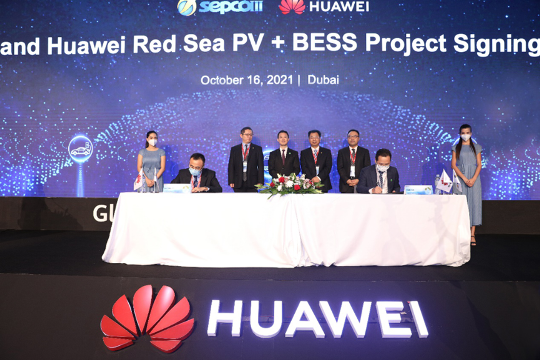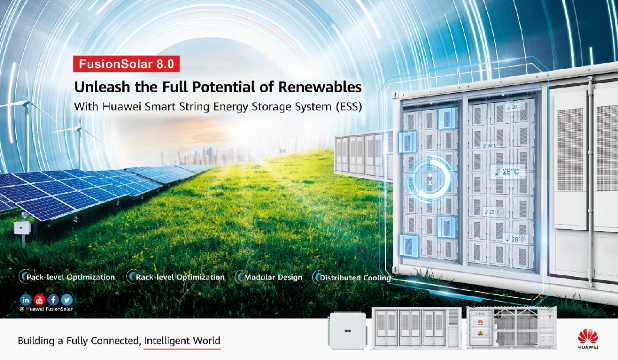Huawei has recently signed the contract with SEPCOIII at Global Digital Power Summit 2021 in Dubai for a 1300 MWh off-grid battery energy storage system (BESS) project in Saudi Arabia, currently the world’s largest of its kind. This project also represents the largest energy storage project since Huawei officially launched the Smart String Energy Storage Solution for utility-scale PV power plants in June 2021.

Sitting on the Saudi Arabian Red Sea coast, the Red Sea project is one of the key projects as part of the Saudi Vision 2030. ACWA Power-led consortium has been awarded a contract to design, build, operate and transfer The Red Sea Project’s sustainable utilities infrastructure. With SEPCOIII serving as the EPC contractor for ACWA Power, the recent contract means Huawei provides its flagship FusionSolar Smart PV + Storage solution for The Red Sea Project, including the 1300 MWh battery energy storage system (BESS), the power conversion system (PCS), and the communications and management system, in addition to solution design, power grid simulation, and related design consulting services.
Future of Sustainable Tourism
Built on the coast of southwestern Tabuk Province, west of the Red Sea, the project covers a planned area of 28,000 km². The Red Sea Project, the world’s most ambitious regenerative tourism project, is expected to attract 1 million tourists every year.
In addition to providing excellent experience according to the highest international standards, the project also set new standards in sustainable development, pioneering a new relationship between luxury tourism and the natural environment, such as 100% reliance on renewable energy.
The intermittent and fluctuating nature of solar and wind power makes energy storage essential for the safe and stable operation of renewable energy projects. So, to achieve 100% reliance on renewable energy, BESS is a crucial foundation to fulfill the ambitious goal for the Red Sea Project.
Chen Guoguang, Chief Operating Officer of Huawei Digital Power and President of Huawei Smart PV, said that the significance of this project as an industry benchmark is demonstrated in the following four aspects:
(1) It is the world’s largest energy storage project and the world’s largest off-grid energy storage project.
(2) It is a pioneer of the safe and stable operation of a PV and BESS-based power system.
(3) It ushers in an era of grid parity, with a much lower cost of power generation than that of traditional power generation systems.
(4) It helps solve the power supply issues currently impacting remote areas, and bridges power gaps all around the world. The solution can withstand extreme environments involving high temperatures, high humidity, and high salinity, all of which occur along the Red Sea coast, and can be applied to other remote areas with poor or no access to power grids.
The project also represents a breakthrough in Saudi Arabia’s search for new economic growth drivers as the country addresses its increasingly depleted oil resources, and it will spearhead a new lifestyle in Saudi Arabia based on its environmental protection commitments.
The world is all working towards making clean energy the primary, or even the only, energy source available. In China, for example, the world’s first all-clean energy ultra high-voltage (UHV) power transmission project was built in Qinghai Province at the end of 2020, delivering clean power to areas up to 1563 km away.
The reasons to choose Huawei
Huawei has more than 10 years of experience developing and researching energy storage systems, and this has been applied throughout a global installed base of more than 8 GWh. In terms of safety, cost-effectiveness, service response and reliability, market reputation, and brand influence, Huawei FusionSolar Smart PV + Storage solution was identified by the customer as the preferred choice and won the contract.
- Ensured independent networking, safety, and stability of large-scale PV plus storage systems: Grid Forming algorithm enables the PV + ESS system to become a reliable voltage source and establish a stable power grid, supporting black start function, enabling the system to switch between grid-tied and off-grid modes, adapt to Extra-low voltage (ELV) power grids and electrical power grids, and support a wide Short Circuit Ratio (SCR) range between 1 and 25.
- Shorter delivery period: The system is compatible with Palletized transportation, and cables do not need to be connected onsite, eliminating the need for onsite battery installation and reducing onsite construction and O&M costs. Considering the hot weather in Saudi Arabia, where the highest temperatures can reach 50°C, Palletized transportation can reduce the time spent by construction personnel in extremely hot locations while also shortening construction times by up to two months.
- Simplified O&M: Huawei uses power electronic technologies to overcome the inconsistencies inherent to lithium batteries, and implements refined management to maximize the battery charge and discharge capacity, while also supporting mixed use of old and new batteries and facilitating maintenance and replacement.
- Distributed cooling extends battery lifespans: The innovative distributed heat dissipation architecture reduces battery attenuation and extends battery lifespans, ensuring long-term stable operation of the energy storage system, particularly in the hot environments of the Middle East.
- Maximum safety: The smart string energy storage system provides three layers of protection, including cell-level AI internal short-circuit detection, rack-level overcurrent protection and fault isolation, and system-level intelligent fire extinguishing linkage protection, enabling proactive warnings about safety issues impacting the energy storage system.

Huawei is a reliable partner for customers all over the world, providing long-term and efficient support in terms of delivery and service. According to the contract, Huawei’s FusionSolar Smart PV + Storage solution will be delivered from June 2022, and the whole project is expected to be completed on March 2023.




